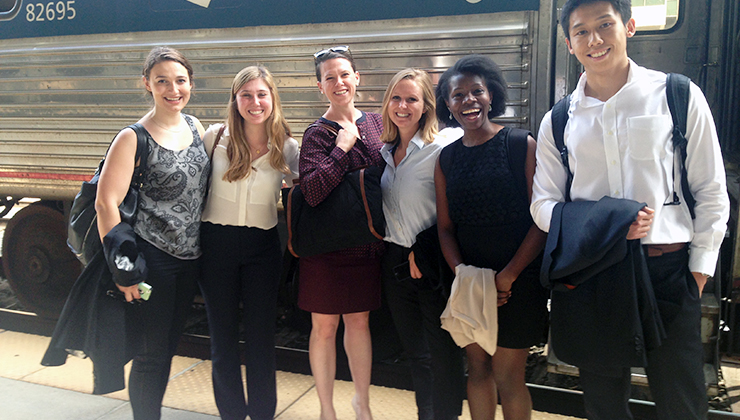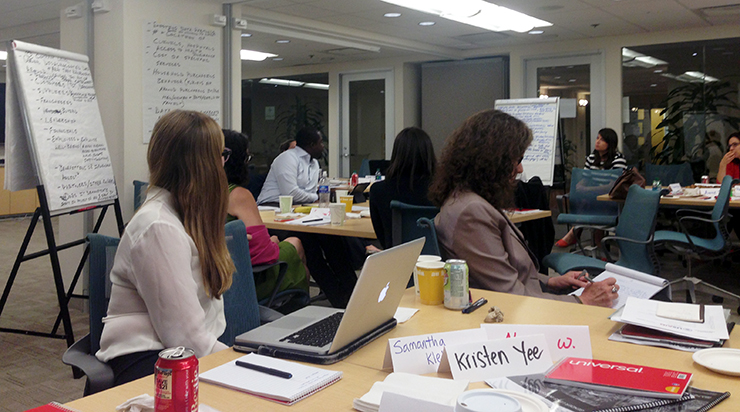Student Perspective: Learning about the Future of Gender Lens Investing
A group of Wharton Social Impact Fellows recently attended “Modeling a Future Gender Lens Investing Portfolio,” a conference hosted by USAID and partners.
These highly engaged students have been involved in research and analysis for our Investing in Women & Girls project this summer, and trekked down to our nation’s capital for the opportunity to learn more about gender lens investing and innovative finance. Here’s what they learned:
As undergrads, we never expected to be sitting in a room and brainstorming with some of the leading minds on gender lens investing.
However, we recently found ourselves in Washington D.C. attending an awe-inspiring conference with WSII Senior Manager Sandi Hunt.
Facilitated by Joy Anderson, founder of the Criterion Institute, and hosted by USAID, Chemonics, and the Criterion Institute, the conference focused on creating a research framework for gender lens investing.
The difficulty of knowing the future outcome of one’s investments and what will affect one’s ROI is intrinsic to unpredictable markets. To combat this, investors use a set of analyses to assess where their money is going. For gender lens investors, gender becomes another category of analysis. That is, these investors take into account how their money will affect both men and women.
Those interested in this nascent idea are trying to collaboratively develop a tool so that all investors can invest with a gender lens. By bringing together impact investors, development agencies, gender experts, philanthropic organizations, foundations, and more, this conference intended to gather insights and ideas on how to build this tool.
When the invitation was passed down to us, we were honored, nervous and excited. Long before the conference, we were asking questions about proper attire before the official agenda was sent out, doing research into attendees before the list was finalized, and practicing introductions days prior. The day of, we set our alarms for 4:45 and paraded to the train station in the rain. Despite a delayed train and a frantic search for a taxi, we made it to the event in time to hear the introduction by Susan Markham and to recite our well-practiced introductions.
Other conference participants were invited to introduce themselves and their work, but to also say what would be useful for them to get out of the day. This collective learning approach set up the ethos of the day, which involved an openness with which participants asked questions about ideas that they did not understand and made suggestions during the discussions.
Throughout the rest of the morning, Joy informed us of her current efforts to create a new framework for analyzing gender lens investing opportunities, to define what those types of opportunities look like, and to begin to build a model portfolio of gender lens investments.
One of the biggest ideas within the new framework is the shift from focusing on enterprises to focusing on industry-level financial systems.
By focusing on higher-level systems, the vehicles of finance could leverage a stronger impact.
We were glad Joy focused on this because as fellows, we found shifting our mindset from enterprises to industries to be one of our biggest challenges throughout the summer. It was hard not to think about how businesses were directing their money and instead to consider how the businesses were being financed. It was validating to see that even the other participants were struggling to think about and recognize the power of macro-level financing.
After lunch, we spent the afternoon in small group discussions where participants brainstormed gender-lens frameworks and practiced applying the framework to case studies. One of the important issues that came out of the small group discussions was that investors often overemphasize their ability to solve problems, including gender issues. Instead, there needs to be more collaboration with gender experts to understand the complexities surrounding gender issues.
These gender experts can also offer insight into what metrics could be used to more effectively measure impact on the lives of women.
Our journey home was more relaxed than the beginning: we easily found a large cab and the train ride home was definitely shorter than the ride to D.C. At the same time, we were riding on the energy from interacting with such knowledgeable and exciting thought leaders for an entire day. We hope that that momentum will carry us through the rest of this summer, and we are looking forward to ways to incorporate this more rigorous framework in our research efforts.
Written by Lynette Ashaba, C’17; Samantha Klein, C’16; Emma Kloppenburg, C’16; Petra Nichols, C’16; Dan Wang, W’18.




